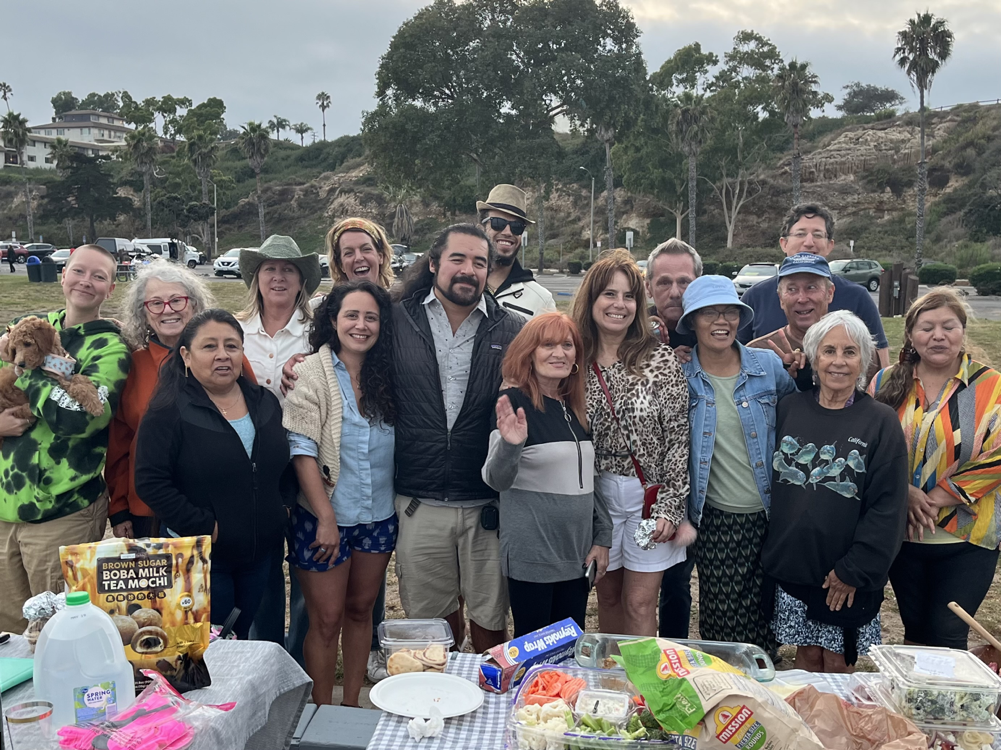This Is What Community Looks Like
At 215 Bath Street, Neighbors Made Homes, Experiences, Connections

This is what community looks like. At least, what’s left of a community. This community represents 10 countries, including Jamaica, Mexico, Sweden, Ecuador, Italy, and the Philippines. This community of young and old, of natives and immigrants, of city workers, artists, Lyft drivers, entrepreneurs, engineers, and seniors share the same address. This community signifies what I envisioned Santa Barbara to be: a thriving, culturally diverse, international community, living in harmony.
The people in the picture are just one quarter of the residents who still live at 215 Bath Street. The forever smiling woman, in the blue fisherman’s hat is Merlinda Goddard who managed the property for 22 years. She raised her children there. Her kindness, care, and generosity of spirit brought the residents of Bath Street together. When escrow closed on the apartment building last month, Merlinda, who innocently signed a Non-Disclosure Agreement with Koto Property Management, was given 30 days to vacate the premises.
In January of this year, UCSB hosted a panel discussion on Urban Place Making that explored the question, “What kind of living environment makes us happy?”
Applying the research of behavioral economists, psychologists, neuroscientists, and city planners, in the book, Happy City, Charles Montgomery explores how city planning and personal decisions can have profound implications for social equity, sustainability, and our overall well-being. In conclusion, Montgomery emphasizes the importance of living a “connected life” and feeling connected to other people.
I trust that two years into his role as Community Development Director, Elias Issacson, who was part of the Urban Place Making panel discussion, is up for the ongoing challenges that distinguish Santa Barbara from his former post in Santa Fe when it comes to housing and human services.
You see, there are 52 units at 215 Bath Street. Fifty-two apartments where, through inclusion, people felt safe and rooted and grew relationships. Fifty-two neighbors who, through shared experiences and familiarity, formed connections. Fifty-two fellow humans who, despite differences, looked out for each other’s well-being and made themselves at home there, over decades.
So still, the question for Santa Barbara, hangs. What will become of communities like 215 Bath Street as affordable housing makes way for tourism?
Around the corner from 215 Bath Street, current hotel projects include Ed St. George’s West Beach Hotel at 302 and 308 West Montecito Street (60 rooms). Another awaits at 517 Chapala Street (35 rooms). Arvand Sabetian has two hotels in the works: 812 Garden Street (30 rooms) and 513-517 De la Vina Street (15 rooms). The biggest hotel project pending boasts 230 rooms at 101 Garden Street, along with the addition of 86 rooms to the Hilton on Cabrillo Street.
To be fair, construction of the affordable housing project, Vera Cruz Village is complete. All 28 units are designated for those with special needs and the homeless. SomoFunk, still in development, will take over an entire city block. The mixed-use project includes 155 residential units with 29 units tagged as “affordable.” Milpas Gardens, proposes 90 residential units with 15 units “below market rate.” Of the 82 units Alan Bleecker and Ed St. George are building at 701 North Milpas, 16 will be offered for those with a “moderate income” — between $80K-$120K annually. The most promising affordable housing project in development is where Tri-County Produce stands on Milpas. Investors are collaborating with local employers to ensure that the rental prices at the 99-unit building meets the income of local workers.
Simple math makes the contrast between hotel rooms and affordable housing units apparent.
Where will long-term tenants living in “workforce” housing go when they find themselves suddenly with no place to go — displaced? What becomes of a city where communities are replaced by commuters? Is it sustainable from an environmental perspective? How do we foster connections with short-term or part-time residents? A half dozen tenants at 215 Bath Street are elderly; who’s looking out for them?
Mike Jordan was correct. This is a life-altering event. Some people will be impacted in a negative way. Some will never recover. Some will move out of town. Some will leave the state.
I returned to Santa Barbara after 15 years away. I returned beckoned by a professional opportunity with the generous support of lifelong friends. I returned, hopeful that Santa Barbara would, by now, have taken some of its glamourous allure, influence, tax money, and charities to be the prosperous, culturally diverse community it portrays.
I stayed, through a pandemic, through the struggles of launching and maintaining a new business. I stayed, despite what Nick Welsh aptly described as “the seismic shifts taking place in Santa Barbara’s grossly overheated rental market.” I stayed, intent to generate millions of dollars, invest in a proper home of my own here, and give back what privilege affords me. But more immediately, I stayed because I found an affordable apartment on Craigslist, met Merlinda Goddard, connected with others, and lived happily for years.
So now, I leave Santa Barbara to this question: When a community is uprooted, what grows in its place?



